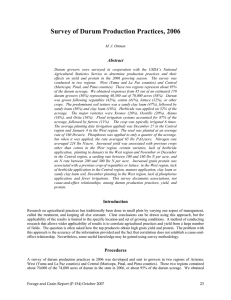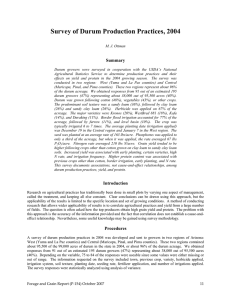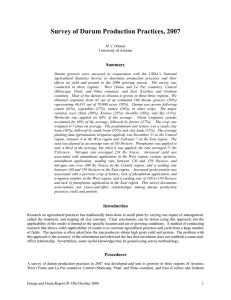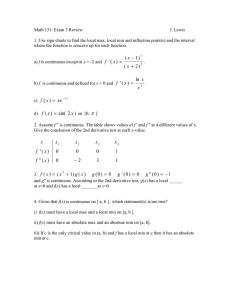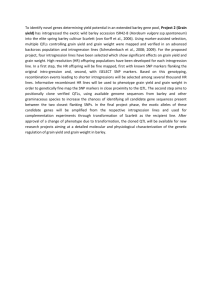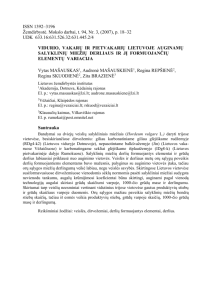Survey of Durum Production Practices, 2005 Summary
advertisement
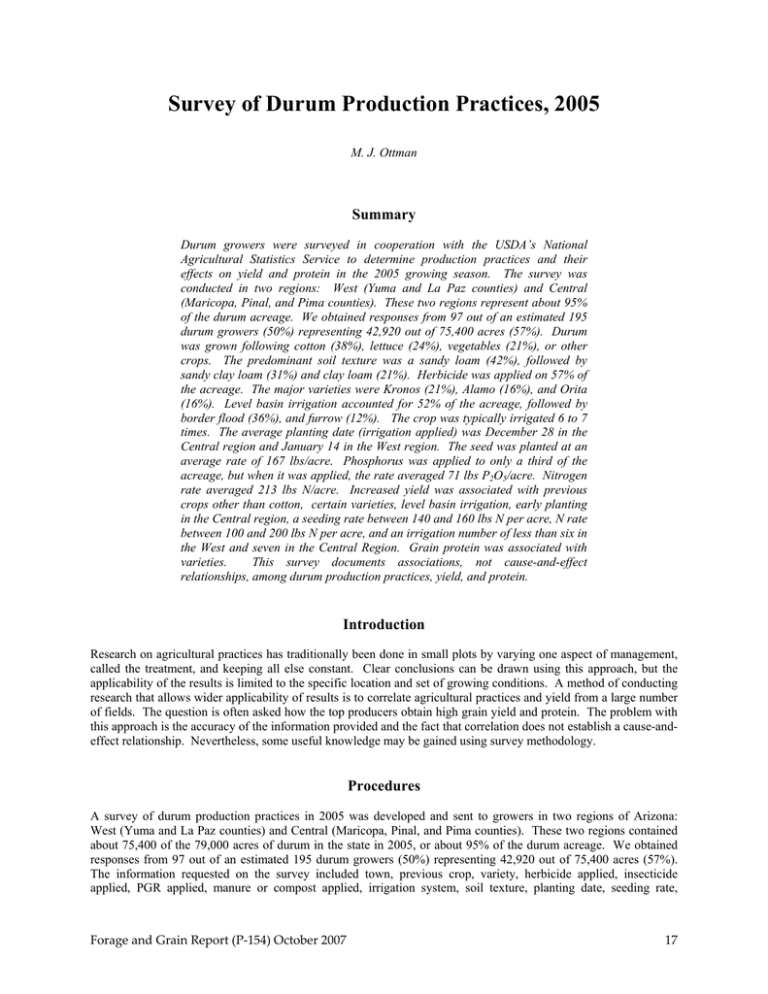
Survey of Durum Production Practices, 2005 M. J. Ottman Summary Durum growers were surveyed in cooperation with the USDA’s National Agricultural Statistics Service to determine production practices and their effects on yield and protein in the 2005 growing season. The survey was conducted in two regions: West (Yuma and La Paz counties) and Central (Maricopa, Pinal, and Pima counties). These two regions represent about 95% of the durum acreage. We obtained responses from 97 out of an estimated 195 durum growers (50%) representing 42,920 out of 75,400 acres (57%). Durum was grown following cotton (38%), lettuce (24%), vegetables (21%), or other crops. The predominant soil texture was a sandy loam (42%), followed by sandy clay loam (31%) and clay loam (21%). Herbicide was applied on 57% of the acreage. The major varieties were Kronos (21%), Alamo (16%), and Orita (16%). Level basin irrigation accounted for 52% of the acreage, followed by border flood (36%), and furrow (12%). The crop was typically irrigated 6 to 7 times. The average planting date (irrigation applied) was December 28 in the Central region and January 14 in the West region. The seed was planted at an average rate of 167 lbs/acre. Phosphorus was applied to only a third of the acreage, but when it was applied, the rate averaged 71 lbs P2O5/acre. Nitrogen rate averaged 213 lbs N/acre. Increased yield was associated with previous crops other than cotton, certain varieties, level basin irrigation, early planting in the Central region, a seeding rate between 140 and 160 lbs N per acre, N rate between 100 and 200 lbs N per acre, and an irrigation number of less than six in the West and seven in the Central Region. Grain protein was associated with varieties. This survey documents associations, not cause-and-effect relationships, among durum production practices, yield, and protein. Introduction Research on agricultural practices has traditionally been done in small plots by varying one aspect of management, called the treatment, and keeping all else constant. Clear conclusions can be drawn using this approach, but the applicability of the results is limited to the specific location and set of growing conditions. A method of conducting research that allows wider applicability of results is to correlate agricultural practices and yield from a large number of fields. The question is often asked how the top producers obtain high grain yield and protein. The problem with this approach is the accuracy of the information provided and the fact that correlation does not establish a cause-andeffect relationship. Nevertheless, some useful knowledge may be gained using survey methodology. Procedures A survey of durum production practices in 2005 was developed and sent to growers in two regions of Arizona: West (Yuma and La Paz counties) and Central (Maricopa, Pinal, and Pima counties). These two regions contained about 75,400 of the 79,000 acres of durum in the state in 2005, or about 95% of the durum acreage. We obtained responses from 97 out of an estimated 195 durum growers (50%) representing 42,920 out of 75,400 acres (57%). The information requested on the survey included town, previous crop, variety, herbicide applied, insecticide applied, PGR applied, manure or compost applied, irrigation system, soil texture, planting date, seeding rate, Forage and Grain Report (P-154) October 2007 17 fertilizer application, and number of irrigations applied. The survey responses were statistically analyzed using analysis of variance. Results and Discussion Durum acreage in 2005 was roughly split between the West (55%) and Central (45%) regions, and grain yield and protein in these regions was not significantly different (Table 1). The county with the greatest percentage of the acreage was Yuma (48%) followed by Pinal (20%) and Maricopa (20%). Grain yield was highest in Yuma and Pinal Counties, and grain protein was not different among counties. Durum was most often planted after cotton (38%), or was planted after lettuce (24%) or miscellaneous vegetables (21%). The highest yields were obtained after lettuce in the West region. The top four varieties in terms of percentage of acreage were Kronos (20%), Alamo (16%), and Orita (16%). Several varieties were grown in both regions, but some such as Kofa and Alamo were predominantly grown in the West region and others such as Ocotillo and Orita were predominantly grown in the Central region. In the West, the varieties were similar in yield and WestBred 881 was the highest in protein, and in the Central region, Kronos was the highest in yield and protein. Herbicide was usually applied to most of the acreage in the West region, whereas only about a third of the acreage in the Central region received a herbicide application. Grain protein was slightly higher in the West when herbicide was not applied. Insecticide was only applied to 8% of the acreage and did not affect yield or protein. Plant growth regulator (PGR) to control lodging was applied to 3% of the acreage in the West but none in the Central region, and yield was less where this was applied. Manure or compost was applied to 13% of the acreage overall, and was associated with lower yield in the Central region. The predominant irrigation system is level basin (52%) followed by border flood (36%) and furrow (12%). Grain yield was highest in the level basin system. Durum was grown predominantly on sandy loam soil (42%) followed by sandy clay loam (31%) and clay loam (21%) soil. Grain yield was lower on sandy clay loam soil compared with clay loam and sandy loam. The average planting date was January 14 in the West region and December 28 in the Central region. Planting date did not affect grain yield in the West region, but in the Central region, higher yield was observed in the December compared with January plantings. The average seeding rate was 167 lbs seed/acre. Highest yields were reported for seeding rates between 140 and 159 lbs seed per acre. The average nitrogen rate was 213 lbs N/acre. In both regions, the highest grain yield was associated with nitrogen rates between 100 – 199 lbs N/acre. The response of the durum crop to nitrogen fertilizer depends on several factors that were not included in this survey such as initial soil nitrogen content. Only about a third of the durum acreage received P fertilizer, but a higher percentage of the acreage in the Central region received P fertilizer than in the West region presumably due to adequate soil P in the West from vegetable production. When P fertilizer was applied, the average phosphorus rate was 71 lbs P2O5/acre. Application of P fertilizer in the Central region was associated with higher grain yield, but again, response to P fertilizer is also influenced by other factors such as soil P. The average number of irrigations applied was 6.6. The number of irrigations applied was associated with yield in both regions. In the West, grain yield was highest if less than six irrigations were applied and protein was highest with exactly six irrigations. In the Central region, seven irrigations was associated with higher yields. This survey has shown that there are some associations between the various durum production practices and grain yield and protein, but these associations do not imply a cause-and-effect relationship. Side by side comparisons are Forage and Grain Report (P-154) October 2007 18 the best way to evaluate the direct effect of varieties, fertilizer rates, or irrigation practices. Nevertheless, there appears to be an association between higher yields and previous crops other than cotton, certain varieties, level basin irrigation, certain soil texture, early planting in the Central region, a seeding rate between 140 and 160 lbs seed per acre, N rate between 100 and 200 lbs N per acre, and irrigation number. Grain protein was associated with certain varieties and six irrigations in the West. Acknowledgements I wish to thank the staff at the National Agricultural Statistics Service for designing and conducting the survey and collating the results. I also wish to thank Larry Aleamoni, Head of the Special Education Department at the University of Arizona, for his helpful suggestions on how to analyze the data. This project was funded by the Arizona Grain Research and Promotion Council. Forage and Grain Report (P-154) October 2007 19 Table 1. Number of survey respondents (N), grain yield, grain protein, and percentage of acres represented by various durum production practices in Arizona. West (Yuma and La Paz Co.) N Yield Protein Acres lbs/a % % Region West Central Significance County Yuma Maricopa Pinal LaPaz Pima Significance Previous crop Cotton Lettuce Vegetables Durum Alfalfa Chile pepper Sorghum Fallow Significance Variety Kronos Alamo Orita Kofa Duraking Westbred 881 Ocotillo Mohawk Crown Sky Significance Herbicide applied No Yes Significance Central (Maricopa, Pinal, and Pima Co.) N Yield Protein Acres lbs/a % % N All (West and Central) Yield Protein Acres lbs/a % % 46 --- 6042 ----- 13.4 ----- 55 --- --51 --5996 --- --13.3 --- --45 46 51 6042 5996 NS 13.4 13.3 NS 55 45 42 ----4 --- 6059 ----5855 --NS 13.3 ----13.6 --NS 48 ----7 --- --15 26 --10 --5644 6388 --5506 ** --13.2 13.5 --13.2 NS --20 20 --6 42 15 26 4 10 6059 5644 6388 5855 5506 ** 13.3 13.2 13.5 13.6 13.2 NS 48 20 20 7 6 5 22 16 1 2 ------- 5739 6352 5824 5800 5250 ------** 13.8 13.5 13.1 13.5 13 ------NS 6 24 21 3 1 ------- 41 ----4 3 1 1 1 6022 ----5962 6255 6000 6000 4300 NS 13.3 ----13.3 14.2 13.5 --13.5 NS 32 ----8 3 1 1 0 46 22 16 5 5 1 1 1 5991 6352 5824 5929 5853 6000 6000 4300 NS 13.4 13.5 13.1 13.3 13.8 13.5 . 13.5 NS 38 24 21 10 4 1 1 0 11 14 1 10 4 5 ------1 5895 6064 7000 6376 5625 5784 ------6000 NS 13.2 13.3 15 13.4 12.8 13.9 ------13 + 17 16 1 9 7 5 ------1 7 --9 3 4 4 10 4 5 5 6909 --5438 5347 6175 5464 5976 6456 6080 5982 * 14.1 --13.3 13.3 13.5 13.1 13.4 13.1 13 13.1 * 4 --15 1 3 4 9 4 4 2 18 14 10 13 8 9 10 4 5 6 6290 6064 5595 6138 5900 5642 5976 6456 6080 5985 NS 13.5 13.3 13.4 13.3 13 13.5 13.4 13.1 13 13.1 NS 21 16 16 9 9 9 9 4 4 3 14 32 6087 6022 NS 13.5 13.3 + 13 42 36 15 6037 5897 NS 13.4 13.2 NS 30 15 50 47 6051 5982 NS 13.4 13.2 NS 43 57 Forage and Grain Report (P-154) October 2007 20 Table 1 (Con’d). Number of survey respondents, grain yield, grain protein, and percentage of acres represented by various durum production practices in Arizona. West Central (Yuma and La Paz Co.) (Maricopa, Pinal, and Pima Co.) N Yield Protein Acres N Yield Protein Acres lbs/a % % lbs/a % % Insecticide applied No Yes Significance PGR applied No Yes Significance Manure or compost applied No Yes Significance Irrigation system Level basin Border Furrow Sprinkler Significance Soil texture Sandy loam Sandy clay loam Clay loam Silty clay loam Clay Sand Significance Planting date Dec Jan Feb Mar Significance N All (West and Central) Yield Protein Acres lbs/a % % 43 3 6042 6030 NS 13.4 13.2 NS 52 3 50 1 5984 6590 NS 13.3 13 NS 40 5 93 4 6011 6170 NS 13.4 13.2 NS 92 8 44 2 6064 5545 + 13.4 12.7 NS 52 3 51 --- 5996 ----- 13.3 ----- 45 --- 95 2 6028 5545 NS 13.4 12.7 + 97 3 42 4 6005 6425 NS 13.4 13.2 NS 51 4 42 9 6105 5489 * 13.3 13.3 NS 37 8 84 13 6055 5777 NS 13.4 13.3 NS 88 12 36 10 ----- 6184 5530 ----** 13.4 13 ----NS 40 15 ----- 14 20 16 1 6421 5963 5772 4300 * 13.3 13.5 13.2 13.5 NS 12 21 12 0 50 30 16 1 6250 5819 5772 4300 ** 13.4 13.3 13.2 13.5 NS 52 36 12 0 22 6242 13.5 18 30 6141 13.3 24 52 6184 13.4 42 11 10 5919 5909 13.2 13.2 21 12 12 6 5475 6424 13.6 13.3 9 9 23 16 5687 6102 13.4 13.2 31 21 1 1 1 6400 5500 4500 * 14 13.5 . NS 3 0 0 1 2 --- 5825 5750 --NS 13.7 12.5 --* 1 3 --- 2 3 1 6113 5667 4500 * 13.9 12.8 --NS 4 3 0 9 33 3 1 5889 6086 6360 5000 NS 13.8 13.2 13.7 13 NS 6 45 4 0 32 19 ----- 6252 5566 ----** 13.4 13.2 ----NS 26 19 ----- 41 52 3 1 6172 5896 6360 5000 NS 13.5 13.2 13.7 13 NS 32 64 4 0 Forage and Grain Report (P-154) October 2007 21 Table 1 (Con’d). Number of survey respondents, grain yield, grain protein, and percentage of acres represented by various durum production practices in Arizona. West Central (Yuma and La Paz Co.) (Maricopa, Pinal, and Pima Co.) N Yield Protein Acres N Yield Protein Acres lbs/a % % lbs/a % % Seeding rate (lbs/a) 75 120-139 140-159 160-179 180-204 Significance Nitrogen rate (lbs N/a) 0-99 100-199 200-299 300-499 Significance Phosphorus applied No Yes Significance Number of irrigations <6 6 7 >7 Significance All N All (West and Central) Yield Protein Acres lbs/a % % --7 10 16 13 --5889 6304 5947 6039 NS --13.4 13.4 13.1 13.6 NS --6 9 24 17 1 3 13 8 26 6000 5667 6476 5763 5866 + 13.5 13 13.5 13.3 13.3 NS 1 1 9 5 29 1 10 23 24 39 6000 5822 6401 5886 5923 + 13.5 13.3 13.4 13.2 13.4 NS 1 7 18 29 45 2 13 24 7 6145 6476 5805 6017 * 13.2 13.2 13.3 14.1 NS 2 14 26 13 7 16 20 8 5000 6156 6110 6261 ** 13.5 13.3 13.3 13.4 NS 7 15 19 5 9 29 44 15 5254 6300 5944 6147 ** 13.4 13.3 13.3 13.7 NS 8 28 46 18 38 8 6040 6049 NS 13.3 13.5 NS 46 9 23 28 5768 6183 + 13.3 13.4 NS 18 27 61 36 5938 6153 NS 13.3 13.4 NS 64 36 10 14 11 11 6470 5880 6027 5873 + 12.9 13.8 13.1 13.4 * 10 12 14 19 23 14 5 9 5837 6111 7000 5667 * 13.4 13.3 13.6 13 NS 22 13 3 8 33 28 16 20 6029 5995 6331 5780 NS 13.3 13.6 13.3 13.2 NS 31 25 17 27 46 6042 13.4 55 51 5996 13.3 45 97 6018 13.4 100 Significance: Statistical significance or probability that differences observed are due to chance. NS = not significant at the 10% probability level, + = significant at the 10% probability level, * = significant at the 5% probability level, and ** = significant at the 1% probability level. Forage and Grain Report (P-154) October 2007 22
